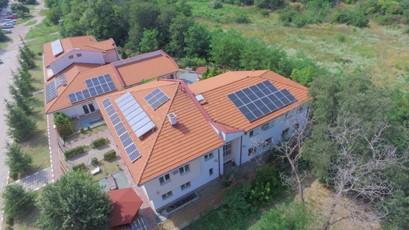
Within the POWERTY project, the Energy Agency of Plovdiv implemented 3 hybrid installations consisting of photovoltaic modules and battery energy storage systems, across three social housing centres owned by the Municipality of Plovdiv. These homes are inhabited by 22 children and young people with disabilities.
The roof installations consist of photovoltaic modules, hybrid inverters, battery storage modules, smart meters, and monitoring systems. The power metering devices monitor energy data in real time, and the cloud-based system is available to monitor and record all sets of data: including generation, storage, and consumption from all pilot installations.
Two of the buildings yield an installed power of 10kWp and battery capacity of 34kWh, while the third has installed power of 5.8kWp and battery capacity of 12kWh. The total estimated power generation for the first two buildings is around 14MWh per year and 8.6MWh per year for the third one. All three buildings present excess production of around 2.5MWh per year for each one of them which is an additional benefit as the excess energy will be fed to the grid. The investment for the three systems was €55,000 without VAT and the estimated payback period is 7.2 years.
The estimated impact from the implementation is the reduced electricity costs of three social buildings, production of renewable anergy of 37MWh per year, 80% of self-consumed renewable energy and excess power of 7.3MWh per year fed into the electrical grid. The avoided CO2 emissions are estimated to 30 t/a with potential monetary savings of €7,600 per year. It also spurred new set-up of the city energy systems and planning for new energy efficiency measures in the public buildings.
In future, based on the feedback from the POWERTY system, different prosumer profiles will be identified thus facilitating optimization through prediction models and dynamic and demand-response tariffs. As the building users have been closely engaged in the process, they are now empowered to aim higher at introducing more energy efficiency measures and achieving greater energy savings. The above-described example is a good practice for introducing a self-consumption model providing a viable solution for social households to achieve a significant share of renewable generation that can be self-consumed and thus decrease their electricity bills and contribute to the decarbonization of the city’s energy system.
Details
- Publication date
- 8 June 2023
